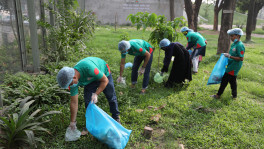How can we increase women’s presence in stem fields?
Bangladesh is at the bottom of the list with only 14 percent female researchers in STEM subjects, while Pakistan, China and Sri Lanka stand at 30 percent, 34.5 percent and 35 percent, respectively

Education and gender equality are integral parts of the 2030 Agenda for Sustainable Development, adopted by the United Nationals General Assembly in 2015. The Science, Technology, Engineering and Mathematics (STEM) fields are key to the Sustainable Development Goals (SDGs): in addressing the various impacts/challenges of climate change, in developing unbiased methods to calculate data to ascertain poverty levels, in improving healthcare management, in determining food security levels and freshwater resources and in developing tools to safeguard biodiversity.
Women are important players in formulating, enhancing and improving lives of an economy, and investing in their talents is necessary for inclusive and sustainable societies. It is predicted that by 2030, 80 percent of jobs in Southeast Asia will require basic digital and applied literacy in the fields of ICT.
The proportion of women in STEM continues to remain the lowest in South and West Asia, holding only 18.5 percent of the research position globally. Bangladesh is at the bottom of the list, with only 14 percent female researchers in STEM subjects, while Pakistan, China and Sri Lanka stand at 30 percent, 34.5 percent and 35 percent, respectively.
The Unesco report titled, "Cracking the Code: Girls' and Women's in Education in STEM" reviewed student learning data across more than 120 countries that participate in large-scale international learning assessments (ILA).
The report highlights the vast gender disparity between middle to high-income countries in learning STEM subjects. This report aims to continually provide deeper insights, based on the ILAs of 120 countries each year, in an attempt to identify and eradicate the obstacles that are causing girls and women to be excluded from STEM across Asia-Pacific and globally. It is a highly sought-after report in implementing policies for governments across education sectors in countries such as India, Laos, Kazakhstan, Malaysia, Singapore, Thailand, Vietnam and Philippines. Unfortunately, among the 120 countries, the report does not comment on Bangladesh due to the country's lack of ILAs.
The International Labour Organisation (ILO) estimates that over the next two decades, with increasing need for automation and ICT, the employability of women who are predominantly in jobs that require little to no STEM skills will be put at risk.

Growing research reveals that women's low interest and intent to pursue STEM subjects in developing countries, often starts as early as at the primary level of education. Pedagogical, psychological, socio-cultural, financial and the absence of continuous support from the family to continue their engagement are often the barriers.
Many young women in developing countries reported that due to lack of proper knowledge about the labour market returns of women in STEM, budget-constrained households tend to term this field as "risky" with "no future".
Women in STEM subjects are lower in developed gender-neutral economies also. In a study conducted with 1,327 Swedish high school students, it was found that lower interest and intent of women in STEM subjects were strongly co-related to women's self-efficacy (what one can do) and social belongingness expectations (what one will get) from STEM careers. While the discouragement may not happen at the household/family-level in developed economies – it is equally challenging for women to pursue careers/studies in STEM.
The discussion on why more and more women is under-represented in STEM fields is not new and has been a reason for concern for many years and with the looming global pandemic, it is worth revisiting what should be ensured at various levels of education and employment development to encourage more participation of women in STEM subjects.
Initiate interest from the primary level
Certain gendered notions are more likely to be picked up at early stages of development and can start affecting the interests that girls may want to pursue. Scientific research has illustrated that there exists little to no difference between boys' and girls' performance and ability in STEM subjects. It has been observed that girls as young as six-year-olds lose interest in STEM subjects as they begin to think that they are less capable than boys their age.
Instilling interest at the primary level in young girls through role-playing, linking and boosting self-efficacy and being mentored for achieving gender balance are a few of the ways.
Teachers at the primary level are pre-dominantly females and a striking study in Israel in 2015 showed that these very teachers harboured biases that were then passed on to female students for years to come. Teachers can play an integral role in fostering confidence by emphasising that intelligence is not fixed nor gender-centric, and can be improved through training and practice.
Sustain interest at the secondary level
Collaborative efforts between teachers and schooling environment will play an important role at the secondary level. Many STEM educators are now moving away from MCQ based assessments to a more blended approach of both MCQs and open-ended questions. This places an emphasis on the interdisciplinary and problem-solving approach. Unesco reports that having a supportive male teacher at the secondary level who provides support, feedback and fosters co-educational learnings (via group work, presentations) in a gender-neutral way has seen to enhance interest among female STEM students.
Schools can help in building and nurturing a community that supports young women in STEM. This can happen via partnerships, forum-exchanges, workshops/trainings, learning-by-doing approaches and encouraging participation in competitions at home and abroad. The launch of "STEMpower Our Girls", "Investing in the future of young Pinays", "Building Trust", "Longitude Explorer Prize", "Cracking the Code" are examples of many successful collaborations between schools in Philippines, Indonesia and the UK that saw not only increases in female participants but also female winners.
Ensure opportunities at the higher education level
Unesco reports that only 35 percent STEM students at the higher education level are women, globally. This gender-imbalance is often a result of decisions that students take while transitioning from pre-tertiary to higher education. Many young females do not take that jump to pursue STEM subjects. A successful transition requires that a student understands the nature of their academic discipline and related labour market returns.
STEM educators have a greater role to play in ensuring that their past alumni networks, collaborations and partnerships can work as windows of opportunities for students to take-up STEM subjects, either in the form of internships/trainings/workshops or placements/trainees upon graduation. The former allows for early engagement for skills development in fields of interest(s) while the latter ensures participation. STEM educators may further support by lobbying for resource-sharing, smaller-class sizes and discussing more female role models.
Higher education institutes can collaborate with each other in arranging career discovery campaigns, mock assessments/interviews, panel discussions, funding for summer schools to learn method(s) which may not be currently available at their institute and creating peer-to-peer STEM network groups. These expose young female students to a pool of minds to understand the practical knowledge impact that they have by being part of various innovative real-world projects and simulations.
Promote and encourage performance/productivity at the employment level
Gender disparity in STEM predominantly begins with the global disparity for females in general, such as concerns of family life which includes pregnancy, fertility treatment, childcare/support and the infamous unequal workload at the household.
In contrast to men, the impact of marital status and the number of dependents during the time-period of a woman's career, is clearly negative. Employers need to ascertain the potentiality of flexible working hours, online skill upgrading and telecommuting to help women in restoring their career trajectories and choices after giving birth.
Workplaces should ensure that participation is not just a mere presence of a female STEM graduate to maintain gender-equality. Effects of gender diversity on team performance and productivity – with full-time female project managers in the workforce - was found to create improved capacity utilization and innovation for technology companies.
Recruitment adverts and techniques can play an important role to attract more women in STEM fields. American Psychological Association reports that adverts for STEM positions often used words like "dominant", "determined" and "strong" which showed significant male bias. This bias continues at the recruitment level where women often are interviewed by a board led by men for positions in STEM fields.
A LinkedIn study reports that women were offered a 10 percent pay-rise upon promotion compared to 30 percent for men in the STEM roles. Moreover, women are paid on average 20 percent-30 percent lower wages than men for the same role. Promoting equal pay will not only generate confidence in the system but will work to improve self-efficacy and productivity.
Skills development should be a continuous process and can start from the workplace. Women in STEM professions can be upskilled by linking them with an experienced supervisor/mentor who can train them to understand, tackle and improve complex projects/situations.
Women already working in STEM fields may also encourage other women by targeting beneficiaries and advocating for their involvement. Creating dialogues, seminars, coaching/trainings for underprivileged female TVET graduates and under-employed women working in entry-level STEM fields can increase their employability.
Thinking ahead…
Research and consultation with sector-specific business associations and key stakeholders to facilitate an action plan, and subsequent changes in curricula so that it is more demand-oriented and STEM-related, can improve employability scopes for women.
The combination of gender equality and nurturing of growth mindset has direct effects on a girl's accomplishments in STEM fields. To understand both scenario and to plan better for the future, extensive research needs to be done. In many developing countries such as Bangladesh, gender-segregated data on STEM students at the SSC/HSC/O&A-Levels, female participation in STEM careers, scope of female employability in STEM fields and presence of skills development, particularly for women coming from disadvantaged households, remains limited.
It is alarming that while many countries have identified areas of barrier for women in STEM at various stages in order to develop an action plan, such as through ILO in Thailand, Vietnam, Singapore, Malaysia, India and Pakistan, Bangladesh is yet to tap any area of research identifying such inequality in education to further foster its economic growth.
Maliha Rahanaz is a lecturer of economics at BRAC University.
Disclaimer: The views and opinions expressed in this article are those of the author and do not necessarily reflect the opinions and views of The Business Standard.


 Keep updated, follow The Business Standard's Google news channel
Keep updated, follow The Business Standard's Google news channel
















